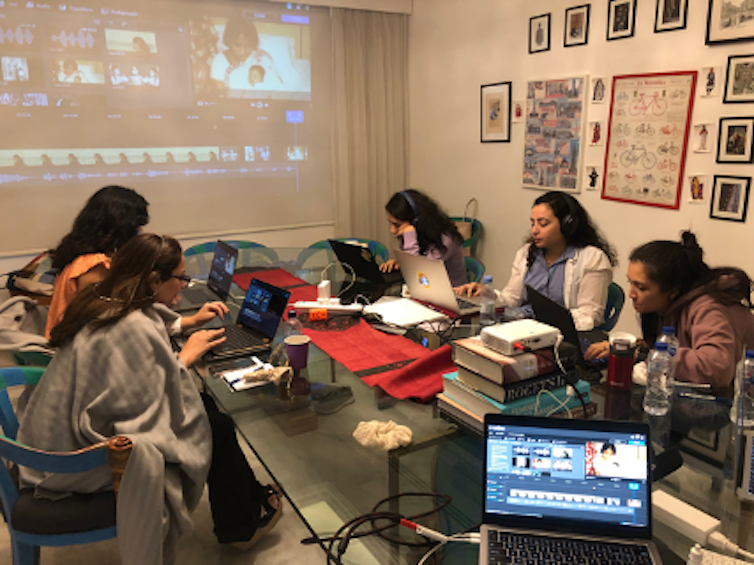Source: The Conversation – Canada – By Emine Fidan Elcioglu, Associate Professor of Sociology, University of Toronto
There is a widely held misconception that young people are politically disengaged. This is based on narrow measures like voter turnout. But this overlooks the fact that many young people are deeply curious, especially when politics is understood more broadly: as a way to make sense of society, power and everyday life.
In my research with youth in the Greater Toronto Area, I explored how their views on inequality, identity and government form over time.
My findings build on my earlier research, conducted with second-generation Chinese and South Asian Canadians, where I found that many of them turned to conservative ideas to access feelings of dignity and belonging. For them, embracing meritocracy wasn’t about denying racism — it was a way to prove they’d succeeded by Canada’s rules.
Read more:
Why are so many second-generation South Asian and Chinese Canadians planning to vote Conservative?
In this new study, I wanted to understand what shapes that gap — what makes some students more likely to see power as structural, and others more likely to see it as personal or cultural.
I found that young people now form political beliefs through two competing knowledge systems: a hollowed-out university, and YouTube’s attention economy. In the university classroom, students learn to connect experience to systems like racism or class inequality. On YouTube, other students encounter simplified stories or common-sense clichés.
The result is a generation pulled between critique and clarity, where YouTube offers answers that feel true.
Changes to postsecondary education
Post-secondary institutions in Canada have historically played a central role in public life. They offered young people a place to explore political ideas, learn history and develop critical thinking skills. That mission has since eroded.
In Ontario, former premier Mike Harris’s so-called “Common Sense Revolution” marked a turning point in government approaches to education. Post-secondary education was rebranded as an individual investment rather than a public good. The cost of tuition increased, public funding stagnated and student debt rose.
As a result, academic paths became stratified. Lower-income students pursued vocational degrees, while their wealthier peers could afford less lucrative paths, like the social sciences and humanities.
The ability to encounter transformative ideas narrowed along class lines.
Market priorities
At the same time, disciplines like sociology and history began to lose institutional standing as universities became increasingly reliant on tuition fees, corporate partnerships and research tied to economic outcomes. Funding shifted toward programs seen to deliver market returns — like business and technology — while fields focused on critique or public interest were sidelined.
This reorientation entrenched the idea that higher education exists to serve the market. So it was no surprise when Ontario announced $750 million in new post-secondary funding; none for the social sciences and far below the $2.5 billion recommended by a government-appointed group tasked with reviewing the financial sustainability of Ontario’s post-secondary system.
Universities are now judged by job outcomes for graduates, with less support for courses that analyze, critique or challenge inequality or power.
YouTube steps in
As universities retreat, platforms like YouTube have increasingly stepped in as a political educator. This is accelerating a shift that may have happened anyway, but has now taken on a new urgency in this hollowed-out educational landscape.
In 2015, YouTube’s algorithm shifted to maximize watch time, pushing content independent of its quality.
I found that for students in technical or vocational programs — where inequality is rarely addressed — YouTube often becomes their main source of political learning.
Conservative influencers offer simplified narratives: inequality reflects natural differences, tradition ensures order, progressivism is elitist.
These messages land because progressive ideas remain concentrated in universities, out of reach for many working-class youth. This dynamic has also expanded across platforms like TikTok and Instagram, where short-form content delivers similar emotionally charged explanations.
When critical education is confined to elite spaces, structural thinking becomes a privilege and not a public tool. This matters because it shapes who feels entitled to analyze power and imagine alternatives — and who is left to make sense of inequality through personal experience and YouTube algorithms.
Some young people are pushing back: BreadTube creators, civic tech projects and public sociology podcasts translate progressive ideas for digital audiences.
Read more:
Meet BreadTube, the YouTube activists trying to beat the far-right at their own game
But these efforts remain small compared to the reach and resources of right-wing media. Without broader infrastructure — from education funding to algorithmic transparency — even the most compelling content struggles to shift how people understand the world.
The decline of progressive institutions
Universities were never the only sites of political education. In earlier generations, unions, political parties and community groups shaped public consciousness.
They established adult education programs, published newspapers and linked political ideas to everyday life. Feminist and anti-racist traditions added their own spaces, from women’s consciousness-raising circles to Black political study groups.
Civic initiatives like Company of Young Canadians, supported youth in under-served communities with political engagement and collective action. These institutions helped working people identify shared interests and organize for change.
That world has largely disappeared, especially with the decline of unions in Canada, driven by decades of neoliberal restructuring that weakened collective bargaining and eroded political education.
In Canada, the New Democratic Party has increasingly prioritized electoral success over grassroots organizing. This isn’t unique to the NDP. Across the North America, left-leaning organizations often function as symbolic communities, struggling to build collective power.
Their abstract language feels out of step with people navigating material problems like rent hikes and job precarity.
In contrast, the political right speaks plainly. And, its messages may be simple, but they are easy to find.
Cultivating critical thought
When universities retreat and progressive organizations lose influence, new forces shape how people come to understand the world.
My research found that the way Canadian youth explained inequality differed depending on their access to education. Students with post-secondary social science education connected personal experience to systemic inequality. Those outside these spaces — especially those relying on YouTube — were more likely to see inequality as natural, rooted in individual effort or cultural values.
This divergence reflects a deeper shift: the pipeline for developing structural literacy has broken down. Where critical thinking was once nurtured through unions, political parties and public education systems, those institutions have thinned out.
With unions weakened and parties consumed with electoral success, the university remains one of the few institutions still cultivating critical thought — and conservative leaders know it.
Ahead of the 2025 election, the Conservative Party pledged to end the “imposition of woke ideology” in university research funding and steer university hiring “away from ideology.”
For from neutral, these efforts turn universities into places where challenging ideas are no longer welcome. In their place, young people are left to navigate politics through platforms shaped by algorithms, where nuance is rare.
A different future
If we want a different future, where more people feel equipped to understand and change the world, we need institutions that foster imagination, inclusion and collective purpose. That means rebuilding unions, community-based groups and civic networks.
It also means rethinking what political parties and universities are for.
Political parties must organize, not just campaign. Universities must educate for democratic participation, not just employability. These institutions must do the slow, relational work of building solidarity: helping people understand the systems they live in and feel part of something larger than themselves.
Without that kind of infrastructure, progressive ideas stay abstract: visible to some, but disconnected from the everyday lives of most.
![]()
Emine Fidan Elcioglu does not work for, consult, own shares in or receive funding from any company or organisation that would benefit from this article, and has disclosed no relevant affiliations beyond their academic appointment.
– ref. YouTube shapes young people’s political education, but the site simplifies complex issues – https://theconversation.com/youtube-shapes-young-peoples-political-education-but-the-site-simplifies-complex-issues-260758



